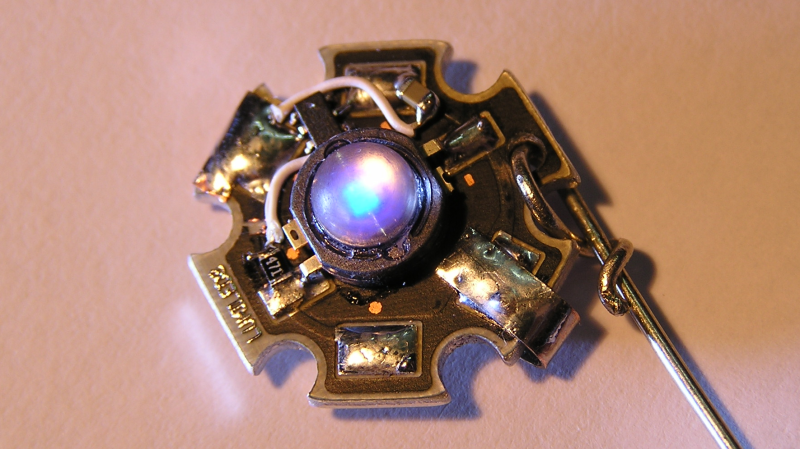With the size of electronic parts and batteries these days, very small items are obviously becoming more and more viable. [Yann Guidon] has made some awesome pieces of LED jewelry using a minimal number of surface mount parts and a small lithium-ion battery. To make the jewelry stand out a bit, other than just blinking on and off, these LEDs blink a short message in Morse code.
This is an update and open sourcing of some work that [Yann] did a few years ago, and the iterations have resulted in a smaller design. But the main part of the latest version is the addition of the Morse code blinking using a small microcontroller. The microcontroller [Yann] used is the SMD version of the PIC10F200, a small, 8 pin PIC microcontroller. This, a resistor and a metal clip are soldered to pads on a Luxeon Star LED. The LEDs are undervolted so they’re not too bright, so the heat sink isn’t really needed, but it’s a good size for the components. Because the LEDs don’t generation much heat, the back of the aluminum frame that the LED is on is carved out a bit so that the small lithium-ion battery can go there.
The final component is the code itself, and [Yann] has released it as an assembly file. An associated text file contains the text of the message that you want the earrings to blink. The text file can contain up to 190 bytes. A shell script converts the text to a file that can be included in the asm file. After that script is run, assemble the code and flash it to the PIC and you’re done!
We’ve seen a couple of other LED jewelry projects done, including this LED engagement ring, and these tiny light-up earrings. You can see video of [Yann]’s project in the video below:



















Although I´m not an English native speaker, I was struck by the beauty of this text, especially the generation part of it.
+1
Since the thermal properties of the aluminum back PCB are not necessary, perhaps it would make more sense to use a conventional PCB? And while we’re at it, swap the coin cell for a rechargeable version to make it economical to run the LED brighter?
The answers : cost.
Oh, and “consumer grade” gadgets don’t mix well with rechargeable stuff.
They use it once, deplete the battery, leave it in a drawer then come back one year later to see the battery is dead for good. As far as I know, if it’s worn 2 or 3 times, it’s already a lot… why bother with making an additional circuit (more expensive) to manage a lithium thing (potentially dangerous, and doesn’t exist in 937 format).
Rich : the battery is a “primary” Lithium cell, not “lithium-ion” (see my comment above :-) )
Furthermore : PIC10F200 exists in 8-pins PDIP but only 6 are used. I use the SOT23-6 version for size.
“Secret” messages are so much fun. About 22 years ago I got the job of building the suit electronics for the Borg on Star Trek First Contact. I encoded messages into the blinking lights on the suits. You never see any one Borg long enough to make out more than a couple of letters, but it was amusing to put them in there.
so what was the message ?
No doubt it was “Resistance is Futile.” At least I would hope so. please tell us what you encoded in the Borg Implants.
May be related: https://www.reddit.com/r/AskScienceFiction/comments/4ez77u/star_trek_why_do_borg_eyepieces_blink_human_names/
http://www.eeggs.com/items/10837.html
http://www.trainweb.org/telegraphgene/MorseMovies/movq-t.htm
Scubabear : May I ask how the “morsing” was implemented ? What type of electronics did you use, processor, platform…
This is quite like a Morse “throwie” I made a few years ago, only much prettier!
This is quite like a Morse-code throwie I made a few years ago, only much prettier!
http://www.instructables.com/id/Throwduino-Basic-Light-Sensing-Flashing-Throwie-/
Ugi